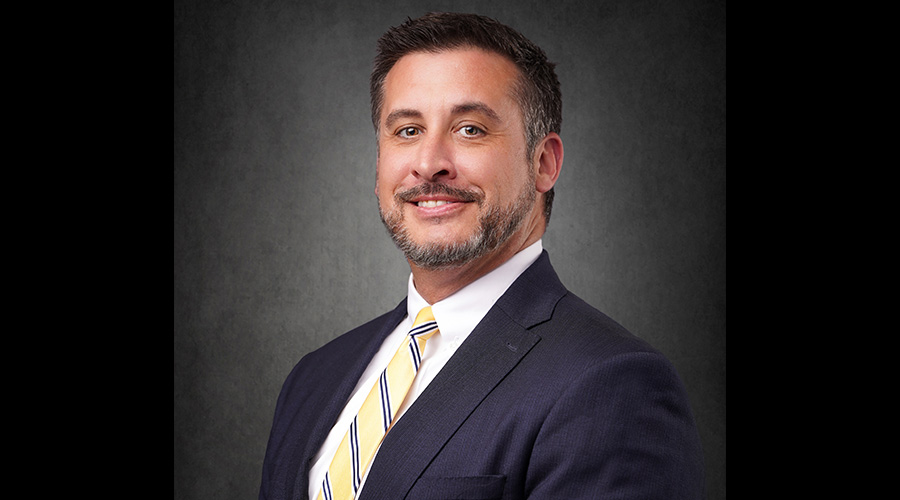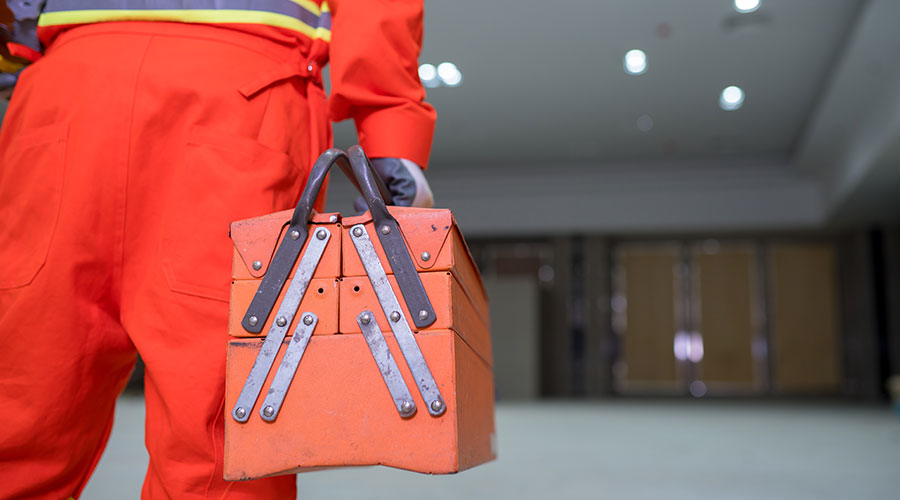Economics Lessons
From assessing needs to reducing energy costs. Ali Kiafar brings financial savvy to districtwide school construction program
Ali Kiafar might have joined the Burbank Unified School District expecting to oversee millions of dollars worth of new construction and renovation projects, but the voters saw things differently.
Nine days after Kiafar assumed facility responsibilities at the district in 1994, voters in the Southern California city defeated a bond measure that would have put Kiafar at the head of a multimillion dollar construction and renovation effort.
Instead, Kiafar would spend the next three years studying the district’s facility needs, meeting with area residents and, ultimately, helping the 21,000-student district win approval for a $112.5 million general obligation bond.
As chief facilities and development superintendent for the Burbank-area school district, Kiafar has overseen construction at kindergarten, elementary and high schools; the addition of parking lots, playgrounds and amphitheaters; and the modernization of classrooms, computer labs and administrative offices. But a mere litany of projects is about as useless to understanding what Kiafar has truly accomplished as trying to gauge a seventh-grader’s civics knowledge by listening to him recite the preamble to the U.S. Constitution.
Kiafar along with his project and construction managers have not only identified and explained the school district’s facility needs to voters but have set the Burbank school district on a path toward green buildings and reduced operating expenses. Since the district’s most recent round of construction started nearly seven years ago, Kiafar has emphasized the importance of designing energy efficient schools and then operating them energy efficiently.
He has also been quick to take advantage of grants and rebates to improve the district’s financial standing and is willing to discuss the district’s facility needs in as much detail as voters can tolerate.
Second Time Around
Taking the time to address voter concerns allowed Kiafar and the district to win voter support for the second bond measure, and he knows it will take at least that level of commitment to keep the district’s facilities in top shape. Over the next four years, Kiafar plans on tackling $30 million in deferred maintenance at the district’s 11 elementary, three middle and three high schools.
“We have to have sound policies to adequately maintain these beautiful facilities for the next 25, 30 or 40 years,” Kiafar says.
Kiafar’s guiding document in deciding what work needs to be done to schools is a report he developed after the bond measure was defeated in 1994. The report, called the “Facilities Needs Assessment,” identified specific renovation and construction measures needed within the schools. The document was instrumental in helping voters understand what was at stake when the second bond measure came up for vote in 1996, and it is still used by the district to prioritize construction and upgrade projects. The district is completing the third phase of the four phases called for in the assessment.
Kiafar’s assessment originally called for more than $173 million of work. Knowing that voters were unlikely to approve such a large bond measure, Kiafar spearheaded the effort to whittle more than $50 million off the request. Reducing the amount of the bond measure, which passed with 74 percent of voters approving the request, involved taking a hard look at exactly what the district needed, versus what the district wanted. Gone were some niceties, including expensive interior finishes, such as stainless steel handrails. In were the necessities, such as less expensive painted handrails and new health and life safety systems.
Making Green a Priority
Systems that would not be eliminated, Kiafar says, were energy-using systems that would affect both the environmental impact of the district’s buildings and the price the district paid to operate facilities. That meant the operable windows in classrooms stayed, and so did the programmable thermostats, which allow teachers to adjust temperature setpoints or override the HVAC system entirely. Motion sensors that control lights in classrooms stayed as well, as did the economizers that allow HVAC systems to operate on 100 percent fresh air when the outside temperature meets the inside temperature demand.
Kiafar has made the performance of building systems a priority during his tenure at the Burbank school district. That’s why the building insulation used in the district’s facilities exceeds California’s already strict Title 24 standards by 10 to 15 percent, he says. It’s also why Kiafar in 1996 started the district’s Energy Conservation and Environmental Efficiency Program. And why Kiafar’s determination to improve building performance led to him working with school board members to approve a resolution calling for every district project to meet guidelines set by the Collaborative for High Performance Schools (CHPS), often referred to as “chips.”
Evidence of the Burbank school district’s commitment to build green facilities can be seen in the systems and components used in schools and from the type of firms Kiafar and the district hire to work on projects. Two of the architectural firms used by the district helped develop CHPS guidelines and contributed to the final CHPS manual. Those affiliations allowed the district to incorporate some of the CHPS guidelines in its building projects even though the program’s manual wasn’t finalized when construction started.
Those requirements are important to Kiafar not only because of the growing evidence tying student achievement to the quality of a school’s indoor environment, but also because they allow the district to save money. That’s been a vital step in helping Kiafar find the $50 million needed to make up the difference between what voters approved in the bond referendum and the cost estimate in the facility assessment.
The strict energy efficiency requirements to which the district has adhered for nearly a decade have resulted in a $50,000 rebate from the Burbank Department of Water and Power for the district’s reduced energy use. Although Kiafar is confident each school in the district could have qualified for the same amount of money, the utility limits the amount per each customer.
Doubling Money
In total, Kiafar says, the district has secured $110 million in grants, rebates and state matching money to pay for things like playground equipment, water fountains and lighting systems.
The district has qualified for such things as low-interest loans from the California Energy Commission for energy improvements that exceed the agency’s minimum requirements and for $100,000 in grants from the state Integrated Waste Management Board.
Kiafar’s ability to find money and to be sensitive to the district’s finances stems partly from his experience prior to becoming a school facility administrator. Kiafar estimates that during his career, which includes work as a facility executive for private-sector companies, he has overseen the design, development and construction of more than $600 million of capital improvement projects. His work at school districts started in 1988 when he joined the Thousand Oaks School District in California, where he worked before joining the Burbank district.
“Frankly, I know it sounds like a cliché, but my passion is for making a difference,” he says regarding his reason to move from the private to the public sector.
At the time Kiafar started working for the Thousand Oaks district, he says, he was one of the first in Southern California to be hired to work specifically with school facilities. Until that time, California districts and others around the nation relegated facility responsibilities to business directors, assistant superintendents for business or other similar positions.
Kiafar says both his work in the private sector and his formal training as an architect and urban and regional planner, for which he earned a doctorate degree, have been invaluable in achieving success for the Burbank school district. As an architect himself, Kiafar is able to make design suggestions to the district’s architects that will meet the district’s needs and reduce costs. In looking at plans for a renovation of a school principal’s office, for example, Kiafar worked with the architect to keep many of the existing walls while reconfiguring space to accommodate the workflow arrangement the office staff wanted. The original plan called for removing existing walls and building new ones.
“Without a design background, it’s sometimes difficult to know how to talk to architects, to understand the intricacies of the process,” he says. “So districts wind up hiring consultants that end up in the long run costing more than it would to pay a qualified staff person.”
Because he works with architects during the design process, Kiafar says, the amount budgeted for a project differs by only 2 or 3 percent from the cost estimate developed by the architect. Without a team of school facility professionals who understand design and construction and get involved in the design phase, Kiafar estimates the difference would be more like 20 to 30 percent.
“Many, many agencies find out that a project will cost too much, and then scrap the school,” he says.
Kiafar isn’t alone in deciding how projects get designed and how interiors are furnished. Facility improvements in the Burbank district are developed with input from an Architectural Advisory Committee. The committee comprises teachers, administrative staff members, members of the district’s parent-teacher association and civic leaders with an interest in school projects.
That type of involvement, Kiafar says, was crucial to helping the district bond measure win voter approval and is vital to giving teachers, principals and others who work at individual schools a stake in school projects. While structural elements and space configurations of individual schools are developed by architects and reviewed by district staff members, Kiafar says schools are allowed to select interior colors, flooring patterns and other interior elements.
“We always seek the input of people who will have to use the facilities,” he says. “It makes for better projects.”
Enrollment in the Burbank school district is expected to stay stable over the next decade or so, Kiafar says. If it were to grow, however, the district would face a challenge siting schools. About five years ago, Kiafar undertook a study to determine how much the district would have to spend to acquire land to build new schools. His figure — $4 million per acre — means the district would likely spend upwards of $15 million just to acquire enough land to build a new school.
That’s why in 1995, when enrollment growth dictated the need for a new kindergarten and elementary school, the district used existing land. Kiafar says the district decided to place the school on a parcel of land containing relocatable classroom structures and a parking lot. Although nobody would likely miss the relocatable structures, the parking lot was necessary, as was the playground space that would be occupied by the new school.
What resulted was a design that gave the district its new kindergarten, an outdoor amphitheater, a 28-classroom elementary school and a two-level parking structure that is partly below grade, Kiafar says. With new facilities occupying the land formerly used by the playground, the district placed the playground on top of the parking structure.
“It’s a solution that works for us,” Kiafar says. “There is always room for improvement in how we go about building schools and implementing our facility needs assessment. People shouldn’t look back and think that everything they’ve done is perfect.”
Green construction: The new efficiency
When the Burbank Unified School District undertakes a construction project, little goes to waste.
From the planning stage of a project to the operation of the building, Ali Kiafar, chief facilities and development superintendent for the district, makes sure a building’s construction and operation are both environmentally responsible and energy efficient.
For example, when the district decided that it needed to modernize facilities, one of the first questions asked was whether existing buildings could be used or whether new construction was necessary. Where new construction was needed, the district made sure that concrete from demolished buildings was used in the base of new buildings or shipped by contractors for use as road base. Brick that was no longer needed was reused elsewhere in the district. Wood floors were used in nearby residences.
Efforts to reuse or recycle as much construction waste as possible, Kiafar says, reduce the amount of debris sent to landfills and help trim construction costs. Contractors are able to sell recyclable items and, as a result, reduce what they charge the district.
In a report titled “Energy Conservation and Environmental Efficiency in Construction Projects,” Kiafar identified 10 areas in which the district has been able to improve building performance. Some highlights of the report are:
Building Envelope: Shading devices, including landscaping, window tinting and window blinds, are used to reduce solar heat gain. In addition, double-glazed windows and insulated window frames are used, as are light-colored roofs, walls and other exterior surfaces to reflect solar energy.
HVAC: High-efficiency units with Seasonal Energy Efficiency Ratio (SEER) ratings of 11 to 13 are used, as are economizers and programmable thermostats to control unit settings.
Lighting: T-8 fluorescent lamps with magnetic ballasts are used in school buildings, as are motion and occupancy sensors. Skylights have been used in some buildings to bring in natural light. At one high school, covered walkways — as opposed to enclosed, conditioned corridors — have been used to connect parts of the facility.
Plumbing: Waste water is recycled for irrigation systems, and low-flow and automatic shutoff valves are specified for projects.
|
Related Topics:












